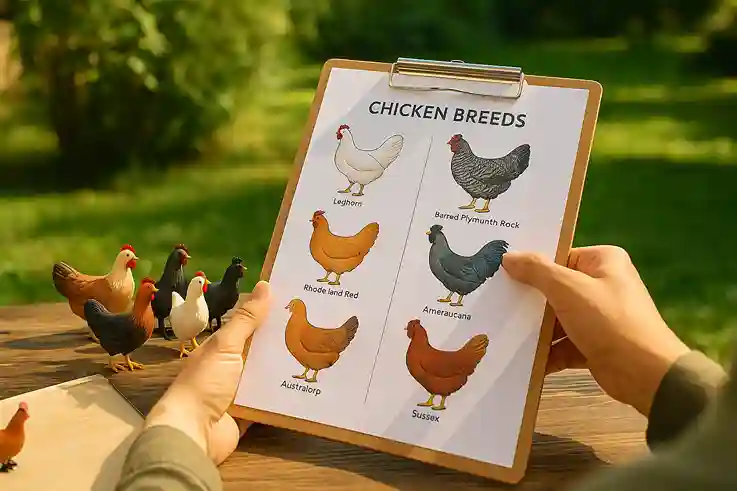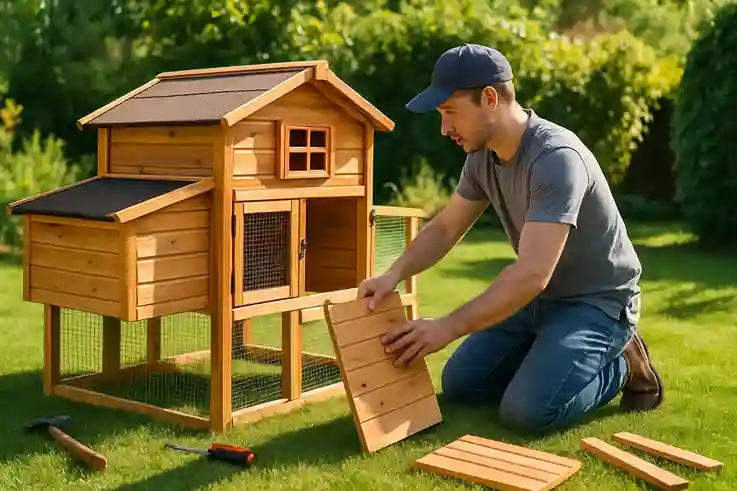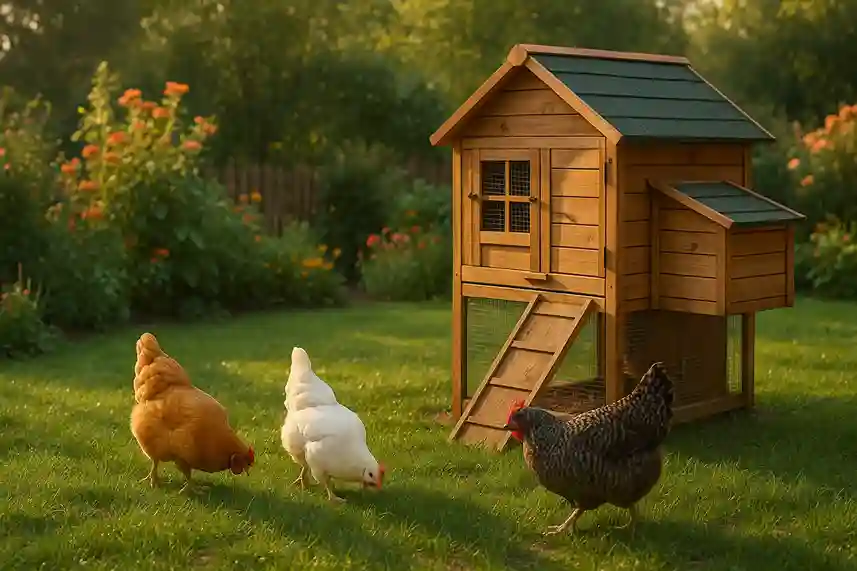Keeping backyard chickens is easier than most people imagine. In fact, the process feels simple once you learn the basics. Chickens fit well in small yards, and they thrive with little space. All they need is a safe coop, clean water, and balanced feed.
The rewards appear quickly. For example, hens provide fresh eggs almost every morning, often richer than store-bought varieties. They also reduce pests by scratching through soil and eating insects. In addition, their droppings create natural compost that improves garden soil and plant growth.
Beyond these practical benefits, backyard chickens bring joy to daily life. Many owners find watching hens roam both calming and entertaining. Furthermore, families discover that children build responsibility while caring for their birds. Neighbour’s may even stop by to share eggs, stories, and laughs.
This guide explains each step clearly. As a result, you’ll see how simple routines lead to healthy chickens and reliable eggs. With these tips, anyone can enjoy stunning results from raising backyard chickens.
Why Choose Backyard Chickens?

Raising backyard chickens offers more than simple enjoyment. In fact, the benefits extend into food, gardening, and daily life. First, chickens supply fresh eggs almost every morning. These eggs taste richer, and they often carry higher nutrients. As a result, many families prefer them over store-bought cartons.
Second, chickens provide a low-cost protein source. Feed and care remain affordable, especially compared to rising grocery prices. Therefore, a small flock quickly becomes an economical choice for households.
Third, chickens improve soil through compost. Their droppings break down into nutrient-rich fertilizer. When added to gardens, this compost enhances growth and boosts long-term soil health.
Finally, backyard chickens create a simple lifestyle shift with big rewards. Owners enjoy fresh food, greener yards, and closer family connections. Moreover, the routine of caring for chickens often feels calming and grounding.
Planning Your Chicken Space
Proper planning makes raising backyard chickens far easier. A well-designed space improves flock health, safety, and productivity.
Coop Location Matters
First, place the coop on ground that drains well. Standing water quickly turns into mud, which breeds bacteria and disease. Elevation helps prevent these problems by keeping the area dry. In addition, choose a location with solid footing. Grass or gravel works better than soft soil, which wears down over time. A stable base makes cleaning easier and reduces stress for the chickens.
Finally, keep the coop close enough to your home for daily checks. Easy access saves time, especially during bad weather. As a result, you’ll maintain routines without struggle and keep your flock healthier.

Ensure Safety from Predators
Chickens attract predators such as raccoons, foxes, and hawks. These animals are persistent, and they test weak points in your setup. Therefore, install strong fencing around the run and coop. Welded wire is safer than chicken wire because it resists tearing. Secure all doors with sturdy latches that raccoons cannot open. In addition, bury fencing at least one foot deep to block digging animals. This step protects against dogs, foxes, and other ground-level threats. For added strength, you can angle the buried wire outward.
Finally, cover the top of the run with mesh or netting. Hawks and owls hunt from above, especially during the day. A roof or net not only stops attacks but also keeps wild birds from spreading disease.
Provide Sunlight and Ventilation
Good airflow keeps the coop dry and fresh. Without it, moisture builds up, creating odors and increasing the risk of disease. Install vents near the roof for circulation. This placement allows warm, moist air to escape while preventing drafts at bird level.
As a result, chickens stay comfortable even during changing seasons. Moreover, sunlight reduces moisture and kills bacteria naturally. A bright coop stays healthier and discourages mold growth. Position the structure where morning light can enter, because early sunshine helps dry bedding quickly.
Finally, combine airflow with light for the best results. Ventilation removes damp air, while sunlight creates warmth and dryness. Together, these elements keep backyard chickens safe and thriving.
Keep Water and Feed Close
Finally, place water and feed within easy reach of the flock. Daily access prevents competition and ensures every chicken eats and drinks well. Use sturdy containers that resist tipping. Lightweight bowls spill easily, which creates waste and attracts pests. Instead, choose heavy feeders and waterers designed for poultry. Hanging options also work because they reduce mess and keep supplies cleaner.
Refill both water and feed every day. Fresh water supports digestion, especially during hot weather. Clean feed reduces mold, which can harm chickens if left unchecked. As a result, your flock stays hydrated, nourished, and far less stressed.
Moreover, keeping supplies nearby saves you time. When water and food sit close to the coop, chores become simpler. Easy routines make caring for backyard chickens sustainable for the long term.
Choosing the Right Chicken Breeds
Selecting the right breeds makes raising backyard chickens far easier. With careful choices, you’ll enjoy healthier flocks and better results.

Breeds That Fit Your Climate
First, match chicken breeds to your local weather. Climate shapes health, egg production, and overall comfort for your flock. Some chickens thrive in hot areas. Breeds like Leghorns and Andalusians handle heat with little stress. They keep laying even during summer.
Other breeds do better in cold conditions. For example, Plymouth Rocks and Orpingtons stay hardy through freezing winters. Their thicker feathers protect them from harsh winds. Therefore, always research climate-friendly breeds before buying. Matching birds to your environment reduces illness, stress, and poor egg output.
Layers for Reliable Eggs
If steady eggs are your goal, focus on strong laying breeds. These chickens are bred to produce consistently, even with small flocks. Their dependable output makes them a favorite for families who want a regular supply of fresh food. Leghorns are well-known for their high egg production. They lay large white eggs, and they keep working through much of the year. Rhode Island Reds are another excellent choice. They provide brown eggs, and they remain hardy in different climates.
As a result, choosing reliable layers means you’ll collect baskets of eggs each week. This steady supply reduces grocery costs and keeps meals fresh. Moreover, families often enjoy the taste and texture of home-raised eggs compared to store-bought options.
Dual-Purpose Chickens
Consider dual-purpose breeds if you want both eggs and meat. These chickens balance steady laying with solid body growth. As a result, they meet the needs of families who prefer flexibility. Popular dual-purpose choices include Sussex, Wyandottes, and Plymouth Rocks. Each of these breeds provides a reliable flow of eggs while also producing a good table bird. Moreover, they adapt well to different climates, making them practical for many regions.
Consequently, dual-purpose breeds often reduce the need for maintaining separate flocks. With one group of chickens, you gain both protein sources. This balance makes them a smart option for backyard chicken keepers who want efficiency.
Mixing Breeds for Strength
Finally, mix breeds for variety and resilience. A diverse flock balances strengths, making the group healthier and easier to manage. Different breeds complement one another in both behavior and productivity. Some hens may excel at laying, while others stay calm and steady. This balance reduces risks from stress, disease, or uneven egg output. In fact, variety often leads to a more stable backyard flock.
Moreover, a mixed group of backyard chickens brings visual charm. Feathers in different colors and patterns make the yard more lively and fun to watch. Families often enjoy the personality differences, as each breed tends to show unique traits.
Quick Guide to Popular Chicken Breeds
| Breed Type | Example Breeds | Best For | Extra Benefit |
|---|---|---|---|
| Climate-Friendly | Leghorn (heat), Orpington (cold) | Adapting to local weather | Reduces stress and health problems |
| Reliable Layers | Rhode Island Red, Leghorn | Steady egg production | Lower grocery costs, consistent supply |
| Dual-Purpose | Sussex, Plymouth Rock, Wyandotte | Eggs and meat | Flexible use for families |
| Mixed Flocks | Combination of breeds | Balanced productivity and resilience | Adds color, variety, and personality |
Setting Up the Chicken Coop
Building a coop the right way keeps backyard chickens safe, healthy, and productive. A good structure lasts for years and reduces daily stress.

Use Sturdy, Weather-Proof Materials
First, choose strong, weather-proof materials for the coop’s frame and walls. A solid structure protects chickens from wind, rain, and extreme temperatures. Wood treated for outdoor use resists rot and lasts longer in damp climates. In addition, pressure-treated lumber helps stop insects from damaging the frame. For roofing, metal panels work well because they shed rain and snow quickly.
Moreover, durable materials reduce repair costs over time. A coop built to handle storms, sun, and seasonal changes saves both money and effort. As a result, your backyard chickens stay safe and comfortable year-round.
Add Roosting Bars and Nesting Boxes
Chickens need roosting bars for rest and nesting boxes for laying eggs. Both provide comfort and security, which directly affect health and production. Place roosting bars higher than nesting boxes. Hens prefer to sleep above ground, and elevated bars make them feel safe. In addition, raised roosts keep feathers cleaner by reducing contact with droppings.
Moreover, give your flock enough nesting boxes to prevent stress. A simple rule is one box for every three hens. This ratio reduces crowding, fights, and broken eggs. Clean, well-lined boxes encourage steady laying and happier chickens.
Ensure Easy Cleaning Access
In addition, design the coop with cleaning in mind. A coop that’s easy to clean saves time and keeps chickens healthier. Large doors make chores faster by giving you space to reach every corner. Removable trays under roosting bars also help because they collect droppings for quick disposal. Likewise, hinged roofs provide top access for deep cleaning when needed. Quick cleaning prevents odors and keeps bedding dry. It also reduces flies, which spread bacteria and stress the flock. As a result, your backyard chickens enjoy a cleaner, safer, and more comfortable home.
Keep Space Comfortable, Dry, and Secure
Finally, maintain a coop that feels safe and comfortable for your flock. A healthy living space directly improves egg production and overall behavior. Use bedding such as straw, hay, or wood shavings to keep the floor warm and dry. Bedding also absorbs moisture, which prevents odors and reduces harmful bacteria. In addition, changing it regularly makes cleaning easier and keeps the coop fresh.
Seal small gaps in the walls to block winter drafts. Cold air at bird level can stress hens and lower egg output. However, always keep roof vents open for airflow. Proper ventilation prevents moisture buildup without chilling the chickens. Strong locks and secure wire mesh protect the flock at night. Raccoons and other predators test weak spots, so latches must stay tight. Moreover, heavy-duty mesh on windows and runs prevents digging or clawing through. As a result, your backyard chickens rest safely every evening.
Feeding Backyard Chickens Right
Healthy diets keep backyard chickens strong, productive, and less prone to illness. Feeding them well doesn’t need to be complicated, but balance matters.
Balance Feed with Grains and Greens
First, start with a high-quality commercial feed. This type of feed is carefully formulated to supply protein, vitamins, and minerals that chickens need every day. It also saves time because you know each meal is nutritionally complete. In addition, supplement their diet with simple grains. Cracked corn, oats, or barley add energy, especially in colder months when chickens burn more calories to stay warm. However, grains should remain a treat, not the main diet, to avoid imbalances.
Fresh greens also play a valuable role. Garden trimmings, safe weeds, or kitchen vegetables give birds fiber and extra nutrients. Moreover, foraging keeps chickens active, which improves their overall health and reduces boredom in the flock. As a result, a balanced diet of feed, grains, and greens supports steady egg production and keeps your backyard chickens thriving.
Add Grit for Digestion
Chickens lack teeth, so grit becomes essential for their health. Without it, they cannot properly break down many foods. Small stones in the gizzard grind feed into tiny, digestible pieces. This process allows nutrients to absorb fully and prevents digestive blockages. In fact, grit works like natural teeth inside the bird’s body.
Therefore, always keep grit available in a separate dish. Unlike feed, grit does not spoil or need replacing daily. However, it should be checked often to ensure supply never runs out. This small step makes a big difference. Proper digestion supports strong growth, steady egg production, and fewer crop problems. As a result, your backyard chickens stay healthier and more productive.
Provide Fresh Water Always
Water is just as important as feed for backyard chickens. Without enough, chickens become weak, stop laying, and risk serious illness. Chickens dehydrate quickly, especially during hot U.S. summers. Heat stress reduces egg production and can even cause death in severe cases. Therefore, reliable water access is critical for flock survival.
Refill water containers daily to keep supplies fresh. In addition, scrub them often to remove algae, dirt, or bacteria. Clean water prevents disease and supports strong digestion. Moreover, consider using shaded or covered containers to keep water cool. In winter, heated waterers prevent freezing and save you from constant trips outside. As a result, your flock stays active, hydrated, and healthy through every season.
Use Kitchen Scraps Safely
Finally, kitchen scraps make a cost-effective supplement for your flock. They reduce household waste and provide extra variety in the diet. Chickens especially enjoy fruits, vegetables, and grains from the table. These treats also encourage natural foraging behavior, which keeps birds active.
However, not all scraps are safe. Avoid moldy food, salty snacks, and processed leftovers, since these upset digestion. In addition, never feed onions, chocolate, or avocado, as they contain toxins harmful to chickens. A clear rule is simple—if you wouldn’t eat it fresh, your chickens shouldn’t either.
Moreover, scraps should never replace a balanced feed. Commercial feed delivers essential protein, calcium, and vitamins that scraps lack. Use leftovers only as small supplements, not daily meals. As a result, your backyard chickens stay healthy while still enjoying variety.
Safe vs. Unsafe Kitchen Scraps
| Safe Scraps | Unsafe Scraps |
|---|---|
| Apples (no seeds) | Onions |
| Leafy greens (lettuce, kale) | Garlic |
| Carrots, cucumbers, zucchini | Chocolate |
| Cooked rice, pasta, oats | Avocado (especially the pit/skin) |
| Berries (strawberries, blueberries) | Moldy or spoiled food |
| Pumpkin, squash, melons | Salty or greasy leftovers |
| Corn (fresh or cooked) | Citrus peels in large amounts |
Tip: Always feed scraps in moderation. Treats should never replace balanced feed.
Daily Care and Simple Routines
Caring for backyard chickens each day keeps flocks healthy and egg production steady. Simple routines make the work easy to manage.
Collect Eggs Each Morning
First, collect eggs each morning. Regular gathering prevents breakage, discourages hens from eating their own eggs, and keeps nests clean. Moreover, fresh eggs last longer when stored quickly.
Check Feed and Water Daily
In addition, check feed and water every day. Full feeders and clean waterers prevent stress and support steady growth. A short daily glance ensures supplies stay fresh and safe. As a result, chickens remain active and productive.
Observe Chickens for Illness Signs
Watch your flock closely while they eat and roam. Drooping wings, pale combs, or sluggish movement may signal illness. Therefore, quick observation allows early action, which often prevents bigger problems.
Keep Bedding Clean and Dry
Finally, maintain clean, dry bedding inside the coop. Wet or soiled litter breeds bacteria, flies, and odor. Replacing bedding often creates a healthier space and keeps chickens more comfortable.
“The ultimate goal of farming is not the growing of crops, but the cultivation and perfection of human beings.” — Masanobu Fukuoka
Frequently Asked Questions
Conclusion
Raising backyard chickens is simpler than most people imagine. With the right coop, balanced feed, and daily care, your flock thrives. Moreover, the rewards are stunning—fresh eggs, natural compost, and a closer connection to your food. In addition, small flocks strengthen families and even build community ties. Every egg collected feels like a step toward a farm-to-table lifestyle right at home. As a result, backyard farming becomes more than a hobby—it turns into a way of living well.
Have you raised backyard chickens, or are you planning to start? Share your experiences, tips, or questions in the comments below.
Your story might inspire someone else to begin their own backyard journey.

Michael Reyes is a versatile blogger with a primary focus on farming and sustainable living. Growing up close to nature, he developed a deep interest in agriculture and enjoys sharing practical tips on backyard farming, modern cultivation techniques, and eco-friendly practices. While farming remains his specialty, Michael also writes on a wide range of topics, from lifestyle and travel to everyday inspiration, making his work relatable to a broad audience.
Outside of writing, Michael enjoys spending time outdoors, experimenting with new farming methods, and exploring different cultures through food and travel. His approachable voice and well-researched insights make his blogs both informative and engaging.


